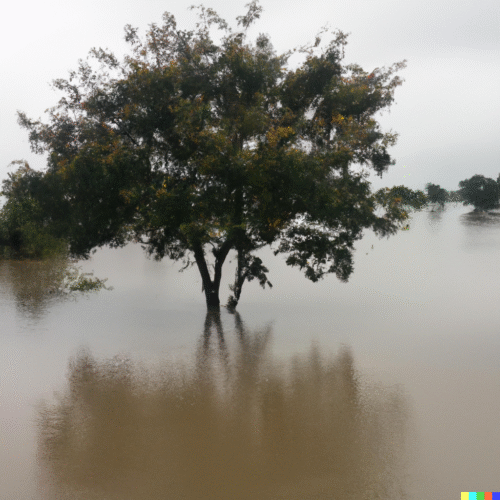While a little rain never hurts anyone, a large amount of rain in a short amount of time can create a range of problems for your garden and especially your trees. If you’ve recently received a significant downpour and are now dealing with flooding, your trees will also likely need attention.
While maintaining your tree is important, you and others safety should be number one priority. If someone’s life is in danger, you should call triple 0 immediately. If a tree has fallen onto your home or vehicle due to flooding or is preventing you from entering or leaving your home, you should call your state specific SES.
Depending on where you are located, you may experience frequent flooding as part of the climate. However, as Australia experiences another La Niña, flooding (especially in the South East) is becoming more commonplace. We explain why flooding is not ideal for your trees and how you can manage any flood damage.
Why flooding is bad for trees
While some tree species such as the River Red Gum, are able to survive significant flooding, the majority of trees do not cope well with being inundated by water. The major issue of flooding is that it causes your trees to become waterlogged. Even after the flood waters reduce, soil can remain too wet for long periods of time.
Too much water means your trees won’t have enough oxygen which can kill your roots and ultimately the rest of the tree. Flooding can also change the soil structure, messing with the soil’s pH levels and can even contain chemicals from agriculture and urban areas which can damage your tree.
If your trees are growing fruits, you’ll want to dispose of any affected produce following a flood. Damp or wet fruit and produce is likely spoiled and should not be consumed. Disposing of the produce will also prevent any pests or birds being attracted to the damp and humid conditions which can rapidly spread disease and cause damage to your tree.
Flooding can also wash away soil banks and cause trees to become unstable, which is a hazard to surrounding properties, vehicles and people.
Symptoms of flooding damage to tree
To see if your tree has been affected by the flood damage, there’s a few symptoms you can check for. The first is that the tree’s leaves are yellow or brown around the edges, leaves are drooping and wilting, and leaves are brittle to touch. You may also notice that the crown has died back and the leaves are reduced in size.
Helping your trees recover
After the flooding has subsided and it is safe to be in close proximity to your tree, you will need to get started on helping your trees recover.
Remove any debris
Flooding and excess rain can cause significant debris so the first thing you need to do is remove any debris around your tree. Even green waste debris can create a world of problems such as attracting pests and keeping the soil wet if left to rot by your tree. Ensure to use appropriate safety gear such as glasses and gloves and dispose of the waste appropriately.
Aerate your soil
The next important step is to aerate your soil which involves pricking, slitting and spiking holes into your soil to allow oxygen in. Aeration will help to drain any remaining water from the soil and help to dry the soil out.
Apply fertiliser
Your trees will likely be missing some essential nutrients as heavy flooding can strip the soil, so you can apply fertiliser to help your tree recover. It’s best to not immediately apply fertiliser after following and begin to reintroduce the nutrients gradually. The type of fertiliser may depend on the pH and clay content of your soil so ensure to test before if you apply any additional nutrients. If you are unsure about the nutrient value of your soil, you can get in touch with a professional Arborist who can assess your trees and recommend a course of action.
Remove hazardous trees
Sometimes the best solution for tree care is to remove the tree entirely. Trees who pose a risk to people, properties and vehicles will need to be removed by a trained tree surgeon as soon as possible. If your tree has been pulled out by the roots, it’s likely going to be incredibly unstable and will also need to be removed. You may also need to prune your tree, removing any broken branches or other dead/dying parts of your tree.
Consult an expert
Ultimately, if you want to ensure that your trees make a full recovery it’s best to consult the experts. At Jim’s Trees, we are able to provide you with professional arborist advice and perform any tree related maintenance so your tree can recover after a flood. Please get in touch with us to discuss your needs today.

